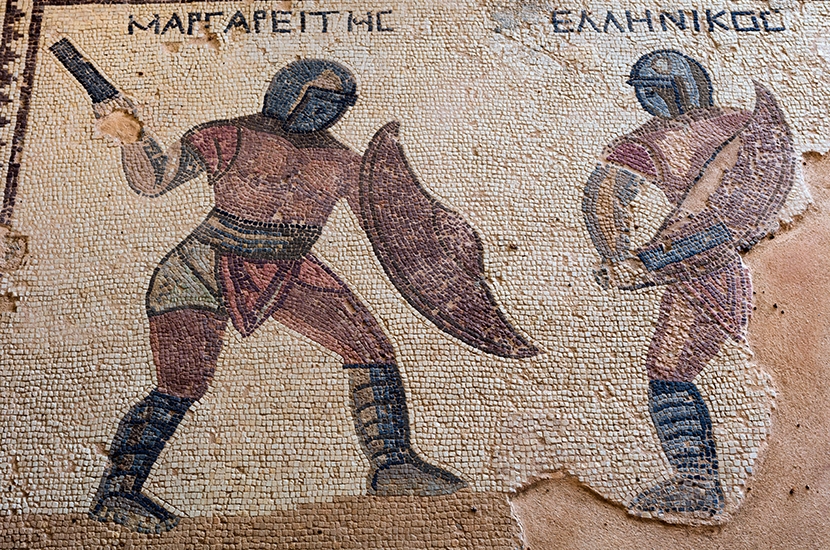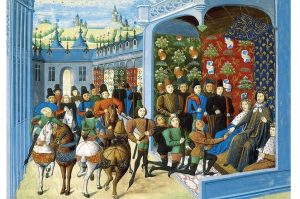Sports history, writes Wray Vamplew, is sometimes ‘sentimental, reactionary and built on the implicit assumption that the sporting past was a better place in which to play games. It wasn’t.’ His own account — the fruit of a career’s work — is so shapeless that it often reads like the encyclopedia that he claims he didn’t want to write. The emeritus professor of sports history at the University of Stirling in Scotland hasn’t managed to assemble his own narrative. But if there is one to be extracted from Games People Played, it’s this: contrary to popular opinion, we may be living in sport’s golden age.
Perhaps the best bits of the book are about ancient sports. We learn that the Greeks had no concept of amateurism or fair play. There is also an entertaining analysis of the finances of Roman gladiators, who were rented out for fights by their managers. Few bouts were to the death, as managers liked to get their revenue-generators back alive, and so patrons tended to save money by granting losing fighters mercy. A select few gladiators racked up more than 50 fights.
Presumably Vamplew here is borrowing somebody else’s research, but we don’t know, because the book has no footnotes. It’s clearly aimed at the commercial as well as the academic market, though his pedantically bureaucratic prose will stymie that hope. He also falls into the trap that he himself warns against — of focusing excessively on western sports. Still, there is a good bit on Mayan rubber-ball games of over 3,000 years ago, which, given the custom of human sacrifice, often ended in death penalties, ‘sometimes for the captain of the losing side, sometimes for the entire losing squad, sometimes for the captain of the winning side, and on rare occasions for the entire winning team’.
Most major sports of today have existed in some form since ancient times. People have always run races against each other or kicked and thrown and hit ball-like objects. ‘Sports historians have now rejected the notion of origin moments for sports,’ writes Vamplew. He cites debunkings of three well-known ones. There is no evidence that William Webb Ellis invented rugby by picking up the ball and running with it during a soccer game at Rugby School in 1823. The story seems to have been first told in the 1870s by an Old Rugbeian, who claimed to have heard it from another.
Similarly, the American legend that Abner Doubleday staged the first baseball game in Cooperstown, New York in 1839 appears to stem entirely from ‘the “memory” of a man who was five years old at the time and whose reliability can be questioned because he ended his life in a mental asylum’. The story was amplified by American nationalists ashamed of baseball’s origins as a British children’s game. Doubleday himself didn’t make the claim in his autobiography. And golf has existed for millennia; it was not invented by a Scottish shepherd, and probably reached Scotland from the Netherlands.
In short, the British didn’t invent modern sports. They codified them, more or less invented sports clubs, and helped disseminate sporting rules. Industrial cities of the late 19th century were big and rich enough, with sufficient public transport, to create markets for spectator sport.
The best time ever to be a player or fan is probably today. All the horrors of modern sports — cheating, drugs, violence, racism, money-grubbing and so on — have always existed. ‘The host of bronze statues honoring Zeus that lined the path through the sacred grove into the Olympic Stadium,’ writes Vamplew, ‘were paid for from the fines levied on cheating participants.’
The difference is that we have got better at handling excesses. For instance, some doped athletes probably won medals at the Tokyo Olympics. But they could still be stripped of them years from now when improved drugs tests retrospectively detect doping in the preserved urine samples. There were only nine positive tests before and during the London Games of 2012, but 60 cheats have been caught since. The Uzbek wrestler Artur Taymazov has lost his golds from both the 2008 and 2012 Games, though he still has the one he got in 2004, thanks to the statute of limitations on retesting.
Today’s players and fans also have an unprecedentedly wide choice of sports. The Football Association banned women’s soccer until 1971. That sport’s recent growth has done its bit for human happiness.
Sporting performance keeps improving, with frequent record-breaking. We are also learning to treat athletes as humans, as witness the general understanding shown to the American gymnast Simone Biles when she withdrew from an event in Tokyo citing mental-health problems. I’ve seen similar progress in soccer academies: 20 years ago, I visited an English one where half-witted coaches ‘bollocked’ the boys in a sort of parody of 1950s’ army culture. Now these places are packed with psychologists, and the vast majority of children who don’t turn pro at least leave with a proper school education.
Violence, too, is being eased out of sport: gone are ice hockey’s street fights and football’s leg-breaking tackles, which is why we have been able to enjoy the genius of Leo Messi and Cristiano Ronaldo for 15 years and counting. The campaign against violence and cruelty has no doubt gone too far for some: the ban on foxhunting may be followed by similar assaults on greyhound and horse racing, suggests Vamplew.
There is richness in this book, but the author should have been dissuaded from cramming in everything he knew. The thematic structure encourages repetition, and his attempts at argument tend to meander into platitude: ‘No theory is immutable. Sports historians must be prepared not only to use theory, but to adapt and modify it.’
All this is a shame, because during Vamplew’s career, this once neglected field inspired an unprecedented amount of research. As he says: ‘Sport is an immensely important part of any serious attempt to reconstruct a nation’s collective life.’ Happily, others are reconstructing it better.
This article was originally published in The Spectator’s UK magazine. Subscribe to the World edition here.


















